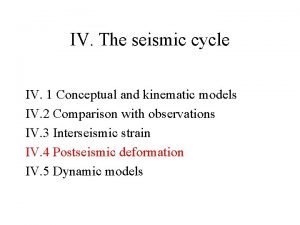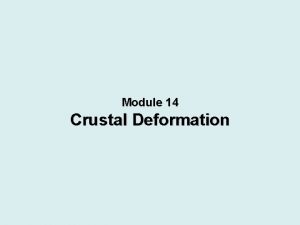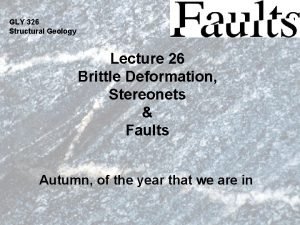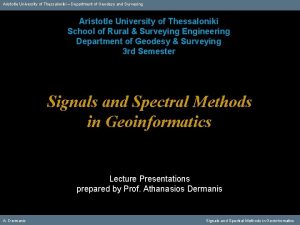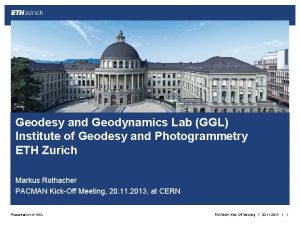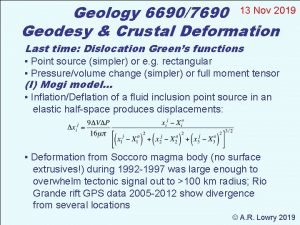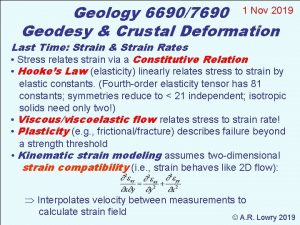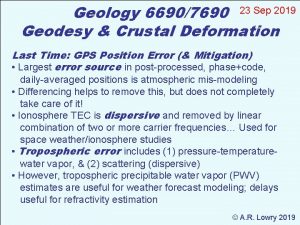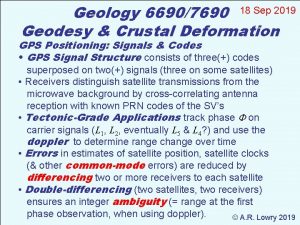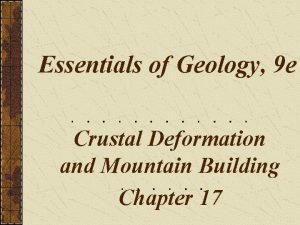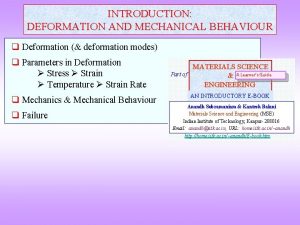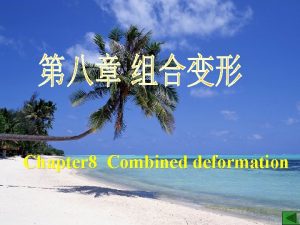Geology 66907690 25 Oct 2019 Geodesy Crustal Deformation











- Slides: 11

Geology 6690/7690 25 Oct 2019 Geodesy & Crustal Deformation Last time: Gravity Reduction: Corrections to terrestrial measurements include: • Tidal attractions to moon, sun and planets • Solid-Earth deformation resulting from those tides • Mass of the atmosphere (from measured surface pressure) • Latitude-dependent correction for Earth’s ellipticity and centrifugal acceleration due to rotation • Free Air correction for height of measurement: (at the equator) • Bouguer correction for mass attraction of topography (Simple Bouguer = 0. 11195 h m. Gal; complete uses full topo) Read for Wed 30 Oct: Wahr § 3. 3 -3. 3. 5 (75 -101) © A. R. Lowry 2019

Read for Monday, Oct 28: Chang et al. (2010) An extraordinary episode of Yellowstone caldera uplift, 2004– 2010, from GPS and In. SAR observations, Geophys. Res. Lett. , 37(23)


Some applications take a further step and calculate a correction for mass that isostatically compensates topography… Implicitly assumes that all loading is topographic mass “piled on” at the surface, and also assumes a lithospheric plate strength (usually local isostasy no strength) Explicitly wrong– there are better ways to address this.

Some applications take a further step and calculate a correction for mass that isostatically compensates topography… Implicitly assumes that all loading is topographic mass “piled on” at the surface, and also assumes a lithospheric plate strength (usually local isostasy no strength) Explicitly wrong– there are better ways to address.

Strain: Stress acting within a continuum induces both deformation and displacements. Below is an example in which stress displaces a point by an amount , and the point by an amount : u x

If is “small”, and strain is infinitesimal (i. e. displacements u, du are very small relative to the scale over which the strain occurs), we can approximate the displacement of the point in terms of the displacement at the point using a first-order Taylor series approximation: i. e. , This term represents the deformation, but does not capture rigid body translation/rotation. To describe these we add & subtract ∂ uj/∂ xi and rewrite as

Here, eij is the strain tensor, and ij describes the rotation tensor. We can write these a bit more compactly using Einstein’s indicial notation as, e. g. , … But it’s useful to see it fully expanded also, e. g. ,

It’s important to keep in mind however that we did use an approximation (truncation of the Taylor series) to derive this relation… If strain is finite rather than infinitesimal, these relations would be inaccurate…

A couple of other useful things to note: • Like the stress tensor, the strain tensor is symmetric. Hence (also like stress) there are only six independent terms. • Units are dimensionless (length over length).

Some useful illustrations of various strains…

